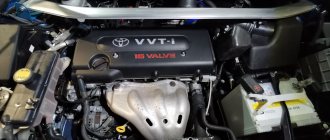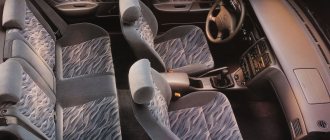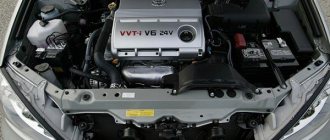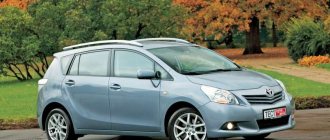About the car produced in 1995
The first generation RAV4 crossovers, coded XA10, were based on the original platform. When creating the chassis, components from passenger cars of the Corolla and Carina models were used. The development of the project under the code designation 153T has been carried out since 1989; in 1991, a decision was made to release a 3-door modification; 2 years later, a variant with 5 doors was introduced into the line of bodies.
The first version to hit the assembly line was a modification with a shortened body; in March 1995, a 5-door version for the US market, equipped with front airbags, began to be assembled.
Restyling
In 1997, crossovers were modernized. The changes affected lighting equipment and bumpers, which slightly changed their outlines. The headlights now have separate lamps for low and high beam, but the interior remains unchanged.
RAV 4 EV with electric motor
In the early 2000s. A version of the RAV4 EV with an electric motor appeared in the production program. The model was sold for 7 months of 2002 in the USA in the state of California. The NiMH battery capacity (95 Ah) was enough for 193 km of travel.
The permanent magnet synchronous motor had a power of 50 kW and developed a torque of 190 N*m. A total of 1,484 copies of the first-generation RAV4 EV were built.
Car cost
In 1997, the price of a new RAV4 without customs clearance in Russia ranged from 21.5 to 27.4 thousand dollars. In 2021, you can become the owner of a crossover for 180-350 thousand rubles; on the secondary market there are copies with both right and left-hand drive. From time to time, RAV4s with a short wheelbase are sold, prepared for heavy off-road travel. Installing additional equipment and painting the body with special “raptor” enamel brings the price to 450-500 thousand rubles.
Using "Raptor"
Car design
The appearance of the car shows the trend of biodesign, popular in the first half of the 90s. last century. The hood, with its integrated honeycomb grille, featured cutouts for headlights. There was a stiffening rib on the side of the doors, and the lower part was covered with plastic covers without paint coating. A spare wheel was mounted on the hinged trunk lid. In addition to the version with a metal roof, a 3-door version with a Softtop roof over the rear seats was offered.
The design of the car is made in the style of the 90s. last century.
Interior and cabin spaciousness
The interior decoration of the car was original and did not overlap with the design of other Toyota models. In front of the driver there was a massive instrument panel with a central section, in which, in addition to the ventilation deflectors, there were climate control control levers and a socket for the radio. On the version without a passenger airbag, a shelf for small items and a cup holder were provided.
The driver and passenger seats could be adjusted in length and backrest angle; the amount of space allowed tall people to be accommodated comfortably. The rear seat on the 3-door version was suitable for teenagers; adult passengers were cramped. The problem was partially solved on the 5-door version with an extended wheelbase, but the lack of interior width remained a drawback of the entire XA10 generation.
The interior of the 1995 RAV4 was original.
Three-door
Configurations of Toyota RAV 4 1995
The basic equipment of the cars included an airbag in the steering wheel and inertial belts for the driver and passengers. The instrument cluster included a tachometer and a block of warning lamps. A standard radio was installed upon request, but all RAV4s produced were prepared for the installation of a player and speakers. In addition to the basic heater with electric fan, manual air conditioning was offered. The interior had a fabric trim, several types of material were provided, leather was not offered for the XA10.
Front disc brakes were standard equipment; drum brakes were used at the rear. It was planned to install an ABS system with electronic balance distribution. Electric windows and rear-view mirrors with heating and remote adjustment were installed upon request.
The steering column could only be adjusted according to the angle of installation; the rear window had a wiper.
Options
Standard equipment included:
- halogen headlights;
- ABS system with electronic force distribution;
- rear fog signal;
- additional brake light;
- heated rear window with wiper system (only for versions with a metal roof);
- instrument cluster with tachometer;
- heater with electric fan.
The list of additional equipment depended on the region of sale. For example, crossovers with an airbag in the steering wheel were offered in Japan or Russia. For North America, a second passenger airbag was required.
SUV 3 doors
For the Japanese market, the option of “free choice” of interior color and exterior color was offered from the list of available options. For other regions, crossovers came with a fixed combination of shades. In addition to the hardtop version, RAV4s were available with an open rear. In case of bad weather, the interior was covered with a canvas top with celluloid windows, which quickly became cloudy and covered with scratches.
An SUV 3 version was offered for the Japanese market.
SUV 5 doors
The cars were distinguished by improved equipment; most copies used air conditioning. A radio receiver with a CD player and an information display was optionally installed. The crossovers used electric drives for mirrors and side windows, and a protective curtain was provided in the trunk. The central locking was driven by a cylinder in the driver's door; the alarm system was installed by dealers at the client's request.
The SUV version 5 featured improved equipment.
Vehicle specifications
Cars of the 1995 model year had a monocoque body that had undergone a cycle of anti-corrosion treatment. A thick paint coating protects the metal well, but pockets of rust appear where the sheets are chipped or broken after an accident. The strength of the structure met the safety requirements of the early 90s. last century, but the body does not provide good protection for the driver and passengers by 2021 standards.
The cars were equipped with an in-line 4-cylinder 3S-FE engine with a displacement of 2 liters, which developed from 128 to 135 hp. With. (depending on the sales market). The engine had a 16-valve timing mechanism and an electronically controlled fuel injection system. The basic version was equipped with a 5-speed manual transmission, and a 4-speed automatic transmission was installed. The torque is symmetrically distributed between the axles, and a center differential is included in the transmission design (when using a manual transmission, hydromechanical locking was used).
The fuel tank was retracted within the wheelbase and held 58 liters. The basic 3-door body had a trunk volume of only 175 liters, but with the rear sofa assembled, the capacity increased to 520 liters. Rack-and-pinion steering with hydraulic booster (included in the basic equipment). The front suspension was equipped with MacPherson struts and a stabilizer; at the rear, an independent linkage design was used, which somewhat worsened the geometric cross-country ability.
Technical parameters (for the version with a 3-door body and automatic transmission):
- length (with spare wheel) – 3965 mm;
- width – 1695 mm;
- height – 1650 mm;
- ground clearance – 200 mm;
- wheelbase – 2200 mm;
- number of seats (including driver) – 4;
- curb weight – 1265 kg;
- permissible total weight – 1630 kg;
- maximum speed – up to 170 km/h;
- acceleration time from zero to 100 km/h is 11.2 seconds.
Vehicle characteristics
As part of the restyling, the Japanese concern began work on cars of the Zero Emission project. The standard crossover body was equipped with an electric motor and a nickel-metal hydride battery with a charging unit and a cable for connecting to an external network. The advantage of the engine was the high torque of 190 N*m, available from minimum speed. The crossovers were built in a limited edition, which was delivered to the USA. Some of the cars were sold, the bulk were used as rental vehicles as part of the promotion of the idea of an electric car.
The RAV4 EV uses electric power assist for the brakes and steering. A heat pump was used to heat the interior; Toyota was the first company to use such a unit on a car. The EV-95 battery was assembled from 24 12 V cells, the total capacity was 2256 Ah. The maximum speed reached 137 km/h, and the range under optimal operating conditions did not exceed 153 km (equivalent to 95 miles).
Charging the battery took about 5 hours, the electronic unit ensured balancing of the elements.
To restore capacity, an original 6 kW unit was offered, the voltage in the circuit was 240 V. Early prototypes used an original type connector developed by Yazaki. The first crossovers had a price in the US of 42 thousand dollars, but incentives allowed them to reduce the cost to 29 thousand dollars. After building 1,484 cars, the project was frozen due to a lawsuit from Chevron, which owned the patent for the battery.
Crossovers of the 1997 model year had a wheelbase of 2410 or 2200 mm. The front wheel track was 1460 mm, and the rear wheel track was 1465 mm, which predetermined low directional stability. All modifications were distinguished by high ground clearance, reaching up to 200 mm. The curb weight of gasoline RAV4s ranged from 1,275 to 1,340 kg, while the electric EV version weighed 1,560 kg. Another drawback of the 1st generation was its small width, amounting to 1694 mm, the passenger compartment was cramped, and the capacity on long trips was only 4 people.
Engine and transmission
Crossovers with a 129-horsepower 3S-FE engine, which had an in-line 4-cylinder block and a 16-valve head with fixed valve timing, were supplied to the Russian market. The engine developed a torque of 178 N*m at a rotation speed of 4600 rpm and was designed for operation on gasoline with an octane rating of 95 units or more. A neutralizer was used to reduce exhaust toxicity, but by 2021 it is impossible to find the unit on surviving cars.
Rav 4 1997 has a 129-horsepower 3S-FE engine.
The transmission included an automatic or manual gearbox (4 and 5 speeds, respectively). The gearbox housing had an angular gearbox with a differential; the power flow was transmitted to the rear wheels by a driveshaft. There was a forced differential lock, which made it possible to increase cross-country ability, but increased the load on the transmission.
Chassis
The modernization did not affect the chassis, the elements of which had no complaints from customers. The front used lower control arms with a ball pin and rubber bushings, MacPherson struts with coil springs and an anti-roll bar. The rear wheels had an independent suspension on arms with a shock absorber and a spring with a stabilizer.
The gearbox was connected to the wheels by axle shafts with constant velocity joints covered with rubber covers.
Dynamic characteristics
Light weight and a streamlined body made it possible to obtain good dynamics. Cars could accelerate to 170 km/h, regardless of body type and gearbox type. The long version with a manual transmission accelerated to “hundreds” in 10.1 seconds, the short-wheelbase crossover with an automatic transmission was 1.1 seconds slower. The dynamics depended on the condition of the road surface and the driver’s skills; the traction control system on the first generation RAV4 was not used, regardless of the model year.
Vehicle handling
The hydraulic booster and rack and pinion mechanism ensured easy control, the minimum turning radius was 5.5 m. The short modification was distinguished by increased maneuverability, but when driving along a rut or longitudinal ridge, the car was unstable. The extended version reacted more calmly to bumps, but the low weight did not contribute to good stability at speeds over 100 km/h.
Fuel consumption
The 1997 RAV4 engine consumed about 12.5 liters of fuel in city mode, which was considered the norm in the late 90s. last century. On the highway, with a uniform rhythm of movement and the presence of 2 people in the car, the car required from 7.9 to 8.1 liters of gasoline. Owners noted that it was difficult to achieve factory values; crossovers burned 13-14 liters in the city and about 9 liters on the highway. The tank, made of galvanized steel sheet, held 58 liters and was located under the bottom near the rear row of seats; fuel was supplied to the injectors by an electric pump equipped with a filter.
Fuel consumption table (factory data)
Pros and cons of the car
Key benefits noted by owners:
- high ground clearance;
- reliable engine and transmission units;
- durable finishing materials;
- ease of maintenance and repair;
- suitability for conversion into an expedition vehicle.
The 1995 RAV4 has good cross-country ability and a reliable engine.
Disadvantages of RAV4 crossovers of the 1995 model year:
- high mileage;
- the lower arms of the rear suspension break when driving off-road;
- corrosion of body elements;
- small luggage compartment capacity;
- cramped rear row of seats;
- poor sound insulation;
- high fuel consumption.
Advantages and disadvantages
The main advantages of crossovers:
- maintainability;
- reliability of main components;
- simplicity of design;
- the presence of permanent all-wheel drive;
- high ground clearance;
- maneuverability;
- low price of spare parts.
Disadvantages of cars indicated in reviews by owners:
- high mileage and natural wear of the body;
- insufficient interior and trunk capacity;
- poor rear suspension design with inclined arms;
- high fuel consumption;
- high noise level in the cabin;
- rigid chassis;
- poor cornering stability from low weight.
Reviews from car owners
Konstantin, 38 years old, Kirov
I was looking for a budget car with high cross-country ability and a comfortable interior. After examining several dozen cars of various brands, I chose a 5-door RAV4 with a manual transmission and a center differential lock. The car has high cross-country ability in snow and mud, the controls are conveniently located. The disadvantages include the cramped rear row of seats; after the purchase I had to change some of the suspension elements.
Vasily, 34 years old, Novosibirsk
From 2015 to 2021 was the owner of a 3-door RAV4 produced in 1995 with automatic transmission. I used the car for trips around the city and outings, regardless of the season and weather conditions. Despite the absence of locks and a low row, the car easily passed where crossovers with an improved transmission were slipping. Due to the short wheelbase, the car did not like icy tracks, and the cabin was noisy when driving.
Eduard, 44 years old, Moscow
In the early 2000s. did an internship in the USA and used a rented RAV4 with an electric motor for 3 months. The car did not differ in appearance from its gasoline counterparts; a different instrument cluster was used in the cabin. The electric drive ensured uniform acceleration, the dynamics were higher than those of analogues with an internal combustion engine. The power reserve depended on the driving style. When the pedal was pressed sharply, the batteries were discharged after 50-60 km; during quiet driving, recharging was required after 140-150 km.









